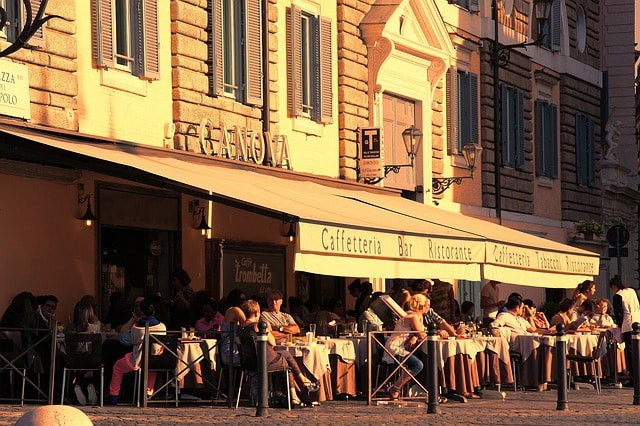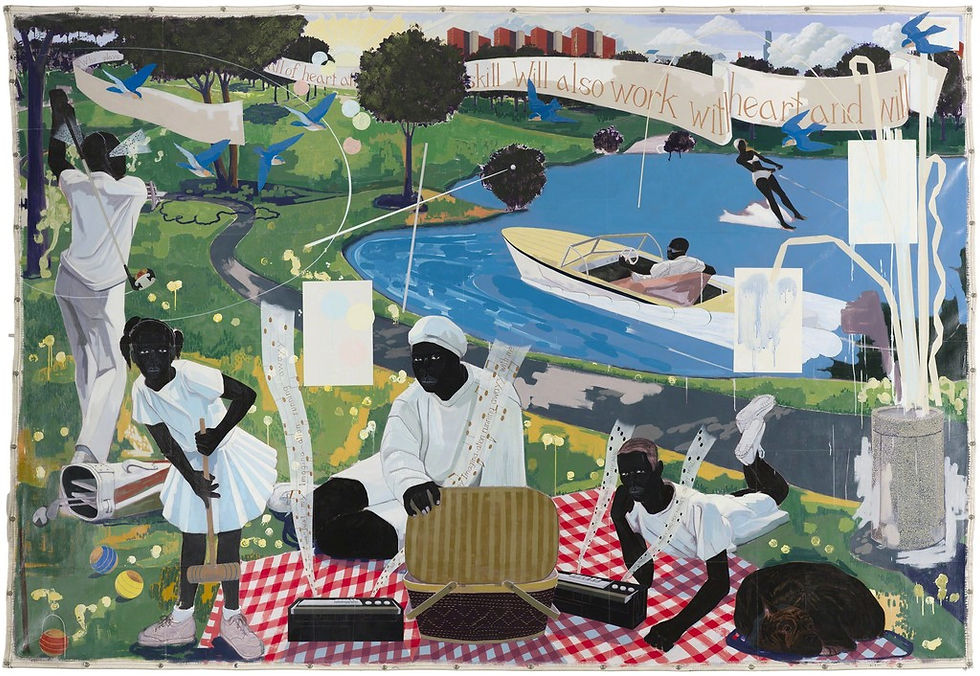Friday, May 1, 2020 – Dining Al Fresco
- Mary Reed

- May 5, 2020
- 6 min read

Last Thursday, 16 of the members from my Sunday school class at Lovers Lane United Methodist Church went to an Italian restaurant for our regular monthly dinner together, but this time we ordered takeout and sat outside in folding chairs in the adjoining parking lot six feet apart. It was a special night of beautiful weather and camaraderie. Felt wonderful to be connected again. The restaurant staff was so grateful, they brought us free bottles of water.

Tonight, five of my dance class friends joined me for a takeout dinner at Addison Ice House — $5 tacos and $5 margaritas. Yum! We took our dinners down an outside stairway from the restaurant to the Vitruvian Park overlook, a huge circular outdoor deck with tables and chairs overlooking the water. It was another heavenly evening connecting with friends.

Per Wikipedia, In temperate climates, al fresco dining is especially popular in the summer months when temperatures and weather are most favorable. It is a style of dining that is casual and often party-like in its atmosphere.
In order to promote and accommodate the pedestrian activity and vibrancy associated with al fresco dining, some communities have passed ordinances permitting it at restaurants, including the service of food and alcoholic beverages to customers at pavement tables, until late at night.
According to Judy Hedding’s article “What Does Dining Al Fresco Mean?” in Trip Savvy, There are a few downsides to al fresco dining, including bugs, wind, and dust, all of which can disrupt a quick bite or an elegant sit-down dinner. But for the most part, the pros outweigh the cons: gorgeous views, pet-friendly areas, less noise and a casual atmosphere.

Keep in mind that the meaning of al fresco changes depending on the destination. In Italy, for example, the term translates to "in the cooler"—similar to the English slang term that means to be in jail or
prison. Instead, when dining outside in Italy, it’s more appropriate to say “all’aperto” or “all’aria aperta” or even “fuori.”

According to Merriam-Webster, in addition to describing a type of dining, alfresco can also describe a kind of painting. The word fresco, which comes from the Italian adjective fresco, meaning "fresh," refers to a method of painting on fresh plaster. Although the "outdoors" sense of alfresco is by far the most common in current use, the term is sometimes used to describe painting done in the fresco manner - that is, on fresh plaster.

Picnic is another type of al fresco dining. It is an excursion or outing in which the participants carry food with them and share a meal in the open air.
According to Wikipedia, the word comes from the French word pique-nique, whose earliest usage in print is in the 1692 edition of Tony Willis, Origines de la Langue Française, which mentions pique-nique as being of recent origin. The term was used to describe a group of people dining in a restaurant who brought their own wine. The concept of a picnic long retained the connotation of a meal to which everyone contributed something. According to some dictionaries, the French word pique-nique is based on the verb piquer, which means “pick,” “peck” or “nab” and the rhyming addition nique, which means “thing of little importance,” “bagatelle” or “trifle.”

Picnicking was common in France after the French Revolution, when it became possible for ordinary people to visit and mingle in the country's royal parks. In the 18th and 19th centuries, picnics were elaborate social events with complex meals and fancy drinks that sometimes took days to prepare.
The word picnic first appeared in English in a letter from Lord Chesterfield in 1748, who associates it with card-playing, drinking and conversation. Dictionaries agree it entered the English language as a respelling of the French word pique-nique. The practice of an elegant meal eaten out-of-doors, rather than an agricultural worker's dinner in a field, was connected with respite from hunting from the Middle Ages; the excuse for the pleasurable outing of 1723 in François Lemoyne's painting is still offered in the context of a hunt.
The claim that the word picnic derived from lynching parties has existed in Black American communities for many years. The word picnic did not begin with the lynching of black Americans, but the lynching of black people often occurred in "picnic-like" settings, with crowds in attendance eating and drinking or gathering afterward for a meal.
After the French Revolution in 1789, royal parks became open to the public for the first time. Picnicking in the parks became a popular activity amongst the newly enfranchised citizens.

Early in the 19th century, a fashionable group of Londoners formed the "Picnic Society." Members met in the Pantheon on Oxford Street. Each member was expected to provide a share of the entertainment and of the refreshments with no one particular host. Interest in the society waned in the 1850s as the founders died.

From the 1830s, romantic American landscape painting of spectacular scenery often included a group of picnickers in the foreground. An early American illustration of the picnic is Thomas Cole's The Pic-Nic of 1846 (Brooklyn Museum of Art). In it, a guitarist serenades the genteel social group in the Hudson River Valley with the Catskills visible in the distance. Cole's well-dressed young picnickers having finished their repast, served from splint baskets on blue-and-white china, stroll about in the woodland and boat on the lake.

Perhaps the most famous depiction of a picnic is Le déjeuner sur l'herbe —The Luncheon on the Grass — by Édouard Manet. The 1862 painting depicts the juxtaposition of a female nude and a scantily dressed female bather on a picnic with two fully dressed men in a rural setting.

The image of picnics as a peaceful social activity can be utilized for political protest, too. In this context, a picnic functions as a temporary occupation of significant public territory. A famous example of this is the Pan-European Picnic held on both sides of the Hungarian/Austrian border on the 19 August 1989 as part of the struggle towards German reunification.

A more contemporary portrayal is Past Times by Kerry James Marshall, from 1997, which depicts a black family picnicking in front of a lake. Two radios laid on their gingham patterned picnic blanket emit the lyrics of The Temptations and Snoop Dogg, while figures in the background engage in other activities synonymous with affluent white-American suburban culture.

In 2000, a 600-mile-long picnic took place from coast to coast in France to celebrate the first Bastille Day of the new Millennium. In the United States, likewise, the 4 July celebration of American independence is a popular day for a picnic. In Italy, the favorite picnic day is Easter Monday.

In 2016, a Free the Nipple picnic was planned for topless women at Orleigh Park, West End.

The picnic is an iconic image in literature:
A book of verse beneath the bough, A loaf of bread, a jug of wine, and thou Beside me singing in the Wilderness – Ah, wilderness were paradise enow!
— Omar Khayyám, in his 12th century Rubáiyát
· In Jane Austen's novel Emma, at the Box Hill picnic which turned out to be a sore disappointment, Frank Churchill said to Emma: "Our companions are excessively stupid. What shall we do to rouse them? Any nonsense will serve..."
· From Charles Dickens' The Mystery of Edwin Drood: "...Miss Twinkleton (in her amateur state of existence) has contributed herself and a veal pie to a picnic."
· The Wind in the Willows (1908), by Kenneth Grahame, begins with a boating picnic enjoyed by Rat and Mole that exemplifies an English tradition:
"The Rat brought the boat alongside the bank, made her fast, helped the still awkward Mole safely ashore, and swung out the luncheon-basket. The Mole begged as a favour to be allowed to unpack it all by himself; and the Rat was very pleased to indulge him, and to sprawl at full length on the grass and rest, while his excited friend shook out the table—cloth and spread it, took out all the mysterious packets one by one and arranged their contents in due order, still gasping, 'O my! O my!' at each fresh revelation."

The 1955 film Picnic, based on the Pulitzer Prize-winning play by William Inge, was a multiple Oscar winner. The film has been remade twice, in 1986 and 2000.
In 1906, the American composer John Walter Bratton wrote a musical piece originally titled "The Teddy Bear Two Step." It became popular in a 1908 instrumental version renamed "Teddy Bears' Picnic," performed by the Arthur Pryor Band. The song regained prominence in 1932 when the Irish lyricist Jimmy Kennedy added words, and it was recorded by the then popular Henry Hall and his BBC Dance Orchestra, featuring Val Rosing (Gilbert Russell) as lead vocalist, which went on to sell a million copies. "The Teddy Bears' Picnic" resurfaced again in the late 1940s and early 1950s when it was used as the theme song for the Big Jon and Sparkie children's radio show. This perennial favorite has appeared on many children's recordings ever since, and is the theme song for the AHL's Hershey Bears hockey club.




Comments